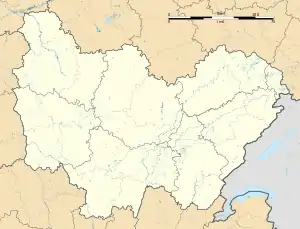Saint-Claude | |
|---|---|
Subprefecture and commune | |
 A general view of Saint-Claude | |
 Flag .svg.png.webp) Coat of arms | |
Location of Saint-Claude | |
 Saint-Claude  Saint-Claude | |
| Coordinates: 46°23′16″N 5°51′50″E / 46.3878°N 5.8639°E | |
| Country | France |
| Region | Bourgogne-Franche-Comté |
| Department | Jura |
| Arrondissement | Saint-Claude |
| Canton | Saint-Claude |
| Government | |
| • Mayor (2020–2026) | Jean-Louis Millet[1] |
| Area 1 | 70.19 km2 (27.10 sq mi) |
| Population | 8,727 |
| • Density | 120/km2 (320/sq mi) |
| Time zone | UTC+01:00 (CET) |
| • Summer (DST) | UTC+02:00 (CEST) |
| INSEE/Postal code | 39478 /39200 |
| Elevation | 360–1,222 m (1,181–4,009 ft) (avg. 441 m or 1,447 ft) |
| 1 French Land Register data, which excludes lakes, ponds, glaciers > 1 km2 (0.386 sq mi or 247 acres) and river estuaries. | |
Saint-Claude (French pronunciation: [sɛ̃ klod] ⓘ) is a commune and a sous-préfecture of the Jura department in the Bourgogne-Franche-Comté region in eastern France.[3] It lies on the river Bienne.
History
The town was originally named Saint-Oyand after Saint Eugendus. However, when St. Claudius had, in 690, resigned his Diocese of Besançon and died in 696 as twelfth abbot, the number of pilgrims who visited his grave was so great that, since the 13th century, the name "Saint-Claude" came more and more into use and has today superseded the other.[4] It was the world capital of wooden smoking pipes crafted by hand from the mid 19th century to the mid 20th century. During WWII the town came under German occupation, yet still remained a haven for Jews escaping to Switzerland due to its proximity to it (about 8 km away, as the crow flies). As a punishment to the locals for consistently assisting and harbouring the fleeing Jews, the Nazis executed all of the town’s males of service age in the town centre. There is a memorial plaque in the city square commemorating the event. Today, there are several farms and ranches surrounding the town that produce many world famous brands of dairy (Comte cheese), beef (Charolaise), and poultry (Bresse Gauloise).
Population
|
| ||||||||||||||||||||||||||||||||||||||||||||||||||||||||||||||||||||||||||||||||||||||||||||||||||||||||||||||||||
| Source: EHESS[5] and INSEE (1968-2017)[6] | |||||||||||||||||||||||||||||||||||||||||||||||||||||||||||||||||||||||||||||||||||||||||||||||||||||||||||||||||||
Transport
Saint-Claude is served by a railway station.
Sport
Saint-Claude has a rugby club. The 2017 Tour de France passed through Saint-Claude. The town's close proximity to the forests and ski resorts makes it a popular destination for hiking, mountain biking, camping, and skiing/snowboarding. Many surrounding lakes (Lac de Vouglans, etc.) also provide numerous fishing and boating activities close to town.
Sights
Saint-Claude Cathedral, former seat of the Bishops of Saint-Claude, is located here.
One of the landmarks in the city is the world largest pipe (7.5 meters long and 8.7 meters high, weighing 600 kg) as a proof of its international reputation as the world capital of pipe manufacturing.
Personalities
- Nadir Belhadj, footballer
- Suzanne Belperron (1900-1983), jewelry designer
- Angelique Boyer, actress
- Mevlüt Erdinç, footballer
- Alexis Vuillermoz, cyclist
- Maud Forget, actress
- Pierre Morel, cyclist
See also
References
- ↑ "Répertoire national des élus: les maires". data.gouv.fr, Plateforme ouverte des données publiques françaises (in French). 2 December 2020.
- ↑ "Populations légales 2021". The National Institute of Statistics and Economic Studies. 28 December 2023.
- ↑ INSEE commune file
- ↑ Herbermann, Charles, ed. (1913). . Catholic Encyclopedia. New York: Robert Appleton Company.
- ↑ Des villages de Cassini aux communes d'aujourd'hui: Commune data sheet Saint-Claude, EHESS (in French).
- ↑ Population en historique depuis 1968, INSEE
External links
- . Encyclopædia Britannica (11th ed.). 1911.